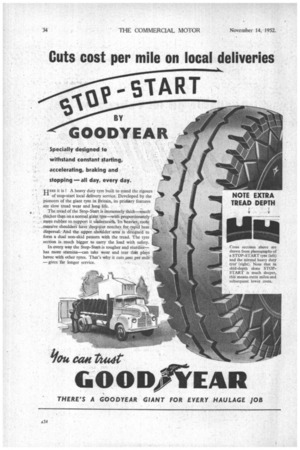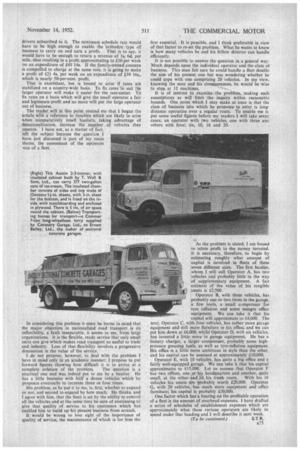Cuts cost per mile on local deliveries
Page 60

Page 61

If you've noticed an error in this article please click here to report it so we can fix it.
START
BY
GOODYEAR
Specially designed to withstand constant starting, accelerating, braking and stopping —all day, every day.
uERE it is I A heavy duty tyre built to stand the rigours ■,..n of stop-start local delivery service. Developed by the pioneers of the giant tyre in Britain, its prirfaary features i are slow tread wear and long life.
The tread of the Stop-Start is immensely thick—muchthicker than on a normal giant tyre—with proportionately ." mote rubber to support it uladerneada. Its heavier, more _massive shoulder§ have deeplcut notches for. rabid heat , dispersal. And the upper. shOUlder area is ae'signed to folia a dual non-skid pattern with the tread. The tyre section is much bigger to carry the load with safety. In every way the Stop-Start-is tougher and sturdier— has more stamina—can take wear and tear that play§ havoc with other tyres. That's why it cuts Aost per mile —gives far longer service.
drivers subscribed to it. The minimum schedule rate would have to be high enough to enable the 'orthodox type of business to carry on and earn a profit. That is to say, it would have to be enough to return a revenue of Is. 6d. per mile, thus resulting in a profit approximating to £10 per week on an expenditure of £49 14s. If the Iamily-owned concern is compelled to charge at the same rate, it is going to make a profit of £21 4s. per week on an expenditure of £39 16s., which is nearly 50-per-cent. profit. • That is exorbitant, but is bound to arise if rates are stabilized on a country-wide basis. To fix rates to suit the larger operator will make it easier for the rate-cutter. 'l'o fix rates on a basis which will give the small operator a fair and legitimate profit and no more will put the large operator out of business.
The reader will at this point remind me that 1 began the article with a reference to troubles which are likely to arise when comparatively small hauliers, taking advantage of denationalization, increase the number of vehicles they operate. 1 have not, as a matter of fact,
left the subject because the question I have just discussed is part of my main theme, the assessment of the optimum size of a fleet.
In considering this problem it must be borne in mind that the major objection to nationalized road transport is its inflexibility, a fault inseparable, it seems to me. from large 'organizations. It is the flexible, ready service that only small units can give which makes road transport so useful to trade and industry. Loss of that flexibility involves a progressive diminution in the. value of the service.
I do not propose, however, to deal with the problem I have in mind only in an academic manner: I propose to put forward figures showing how difficult it is to arrive at a
complete solution of the problem. The question is a practical one and was .indeed put to me by a haulier. He has a little business with half a dozen vehicle's which' he proposes eventually to increase three or four times.
His problem, as he put it to me, is, first, whether to expand or not, and second to expand by how much. He thinks, and I agree with him, that the limit is set by the ability to control all the vehicles and•at the.same time be sure of continuing togive that quality of service to his customers which has enabled him to build up-his present business from scratch.
It would be wrong to lose sight of the importance of quality of service, the maintenance of which is for him the first essential. It is possible, and I think preferable in view of that factor to re-set the problem. What he wants to know is how many vehicles he and his fellow director can handle efficiently.
It is not possible to answer the question in a general way. Much depends upon the individual operator and the class of business. This man felt sure he could-handle a fleet double the size of his present one but was wondering whether he could cope with one comprising 20 vehicles. In my view, knowing the man and his circumstances, he would be wise to stop. at 12 machines.
It is of interest to examine: the problem, making such assumptions as will lienit'the' inquiry within reasonable bounds. One point which I may make at once is that the class of business into which he proposes to enter is longdistance operation over a regular route. To enable me tc put some useful figures before my readers I will take seven cases; an operator with two vehicles, one with three an others with four, six, 10, 16 and 20.
As the problem is stated, I am bound to relate profit to the money invested. It is necessary, therefore, to begin by estimating roughly what amount of capital is involved in fleets of these seven different sizes. The first haulier. whom I will call Operator A, has two vehicles and probably little in the way of supplementary equipment. A fair estimate of the value of his tangible assets is £2,500.
Operator B, with three vehicles, has probably one or two items in the garage, a few tools, a small compressor for tyre inflation and some meagre office equipment. We can take it that his capital will approximate to £4,000. The next, Operator C, withfour vehicles, has rather more garage equipment and still more furniture in his office, and we can put him down at £6,000, whilst Operator D, with six vehicles, has invested a little. more'in garage equipment. He has a battery charger, a larger compressor, probably some highpressure greasing tools, as well as tyre-inflation equipment. His office is a little more ambitious in style than the other, and his capital can be assessed at approximately £10,000.
Operator E. with 10 vehicles, has quite a big office and a fairly well-equipped garage. We can take it that his captial approximates to £15,000. Let us assume that Operator F has two offices, one at his headquarters and another, quite small, at the otherend:ef.. his trunk route. With his 16 vehicles his assets are Probably worth £20,000. Operator G, with 20 vehicles, -has much more equipment and office furniture; his capital is probably £30,000. One factor which has a bearing on the profitable operation cif a fleet is the amount of overhead expenses. I have drafted a series of schedules of establishment expenses which are approximately what. these various operators are likely to spend under that heading and I will describe it next week.




























































































